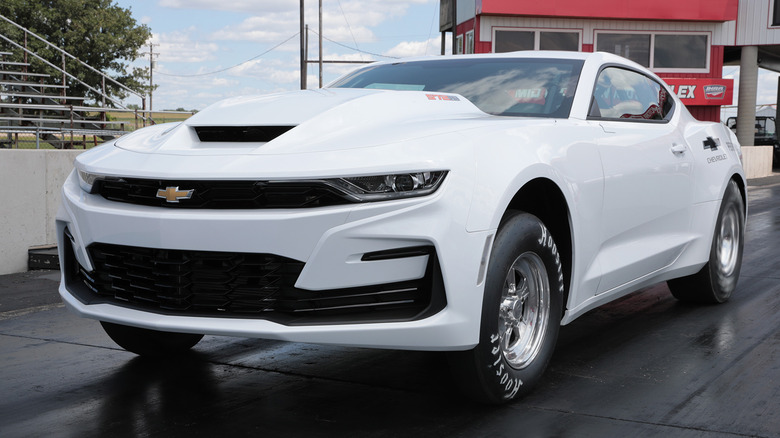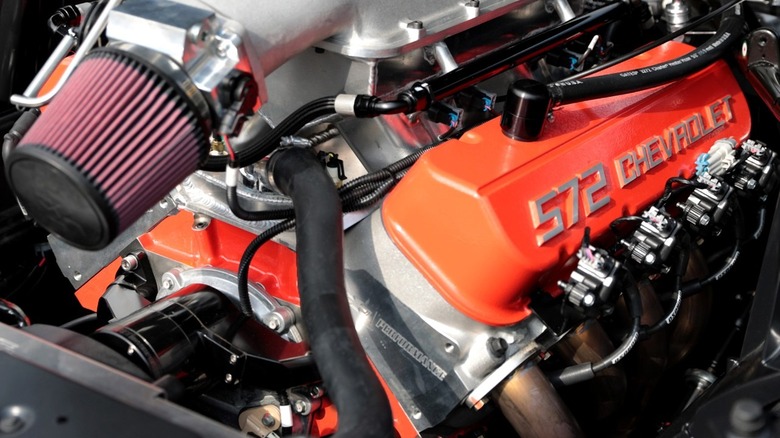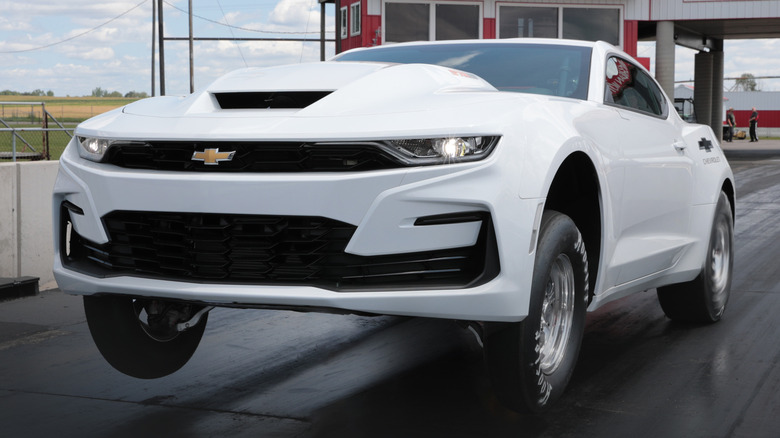This Chevy Camaro's Engine Is So Big, It's Illegal
Until very recently, muscle cars weren't known for being an economical, environmentally friendly option; instead, they were characterized by raw power and most of that power came from the big, thirsty engine rumbling away under the car's mile-long hood. Despite several major manufacturers producing and promoting greener options, old-school muscle cars still have a huge following.
Chevy Hardcore's Randy Bolig is one of those old-school muscle car enthusiasts. He summed up his — and many other people's — feelings quite succinctly in an article he wrote about why electric cars weren't for him. In summing up his love of classic cars, and his dislike of where the automotive industry seems to be heading, Bolig says: "I like to hear a screaming V8 at full song. I like the fact that driving a classic is an experience, not just something that has to be done to get to work. In short, I like old cars. That said, I am not a fan of what the automakers feel the auto industry should become — battery-powered."
Although electric is on course to become the vehicular norm in the next few decades, enthusiasts shouldn't worry too much. Alongside the classics that are still around, gas-powered behemoths are still rolling off the production line and will continue to do so for the foreseeable future. In addition to the standard models, some manufacturers like Chevrolet are still pushing the boundaries of petroleum power — in fact, the Motor City-based manufacturer has released a car with an engine so big that you're not allowed to take it on the road.
The world's biggest passenger car engine
In the normal world, a 6.5-liter engine is considered to be quite large. Chevrolet has decided to venture well beyond this and has crammed something closer to what you'd find pulling a semi-truck in the front of its 2022 COPO Camaro. As things stand, the COPO's incredible naturally aspirated 9.4-liter V8 is the largest you'll see powering a production passenger vehicle.
However, size doesn't necessarily translate to performance. Despite the enormous volume of its cylinders, the COPO Camaro's 9.4-liter engine only produces around 430 horsepower. If you're looking for raw grunt, opting for the slightly smaller 5.7-liter COPO Camaro will give you an additional 130 horsepower, partially due to efficiency and partially due to the supercharger the 5.7-liter engine has attached to it. The smaller engine is fitted to Chevvy's small block platform, while the larger option comes fitted to a big block platform similar to what the company installed in its vehicles back in the 1960s — an era that was arguably the golden age of the muscle car.
If 9.4 liters still seems a bit too small for you, and you have the means to source and fit an even larger engine, you have the option to buy the COPO Camaro a rolling chassis. The 9.4-liter COPO Camaro would certainly be a talking point in any garage, but it isn't cheap. If you want to snag one new, you can expect to pay at least $105,000 (via Chevrolet). Like the other COPO Camaros, the 9.4-liter version comes with a weight-saving carbon fiber hood and the option of a trunk-loaded parachute for drag racing. But despite the extras, the big-engined beast may be the least practical car you could spend six figures on for one major reason.
You can't take the 9.4-liter COPO Camaro on the road
You can use the faster, more expensive, smaller-engined versions of the COPO Camaro as a daily driver and not suffer any issues beyond the fact a parachute is taking up some valuable trunk space and the roll cage is limiting the number of passengers you can fit into the cabin. The larger engined variant doesn't have that luxury.
As Motor Illustrated explains, the 9.4-liter version has not been designed for the street and doesn't come supplied with a Vehicle Identification Number (VIN). It can't be registered, can't be insured like a regular car, and can't be driven on public roads without the police showing up and charging the person driving the plateless powerhouse with a litany of offenses. Instead, the 9.4-liter COPO Camaro's natural habitat and the only place you can take it without falling foul of the law is the track or the drag strip.
You may then question why Chevvy has bothered to build a 9.4-liter version of a vehicle that is less economical, offers worse performance, and is less practical than other versions of the exact same vehicle. So do we, and only one answer comes to mind: because it can.


